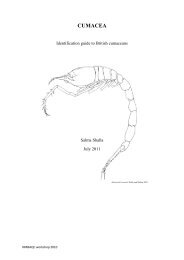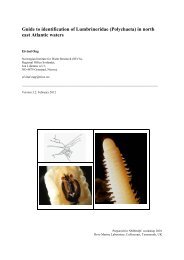s A Field Guide to the British Seaweeds - NMBAQC
s A Field Guide to the British Seaweeds - NMBAQC
s A Field Guide to the British Seaweeds - NMBAQC
You also want an ePaper? Increase the reach of your titles
YUMPU automatically turns print PDFs into web optimized ePapers that Google loves.
Axial cell<br />
• Distal– Towards <strong>the</strong> base or point of attachment<br />
• Holdfast – <strong>the</strong> structure for attachment <strong>to</strong> substrate, may be root-like, single<br />
cell or group of cell, disc or claw-like. Apparent encrusting forms may<br />
sometimes be basal portions of erect plants e.g. some encrusting calcareous<br />
forms may just be expanded basal portions of Corallina, some non-calcareous<br />
red ones may be bases of Mas<strong>to</strong>carpus<br />
• Lamina – <strong>the</strong> blade of flat, leafy or foliose algae<br />
• Membranous – forming a thin layer, may be semi-transparent,<br />
often sheet-like<br />
• Pinnate – branching arranged like fea<strong>the</strong>r plumes<br />
often in a single plane<br />
• Polysiphonous – a ring of cells (siphons or pericentral cells)<br />
located around a central or axial cell<br />
Pericentral cells<br />
Claw-like holdfast Discoid holdfast<br />
Reduced species list identification guide as required by <strong>the</strong> Water Framework Directive 18




